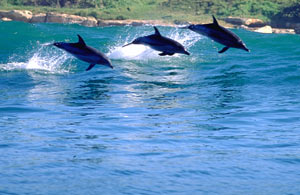Dolphin and Whale Watching
in South Africa
South Africa is an awesome dolphin
and whale watching destination as there is a large population of resident
cetaceans, and many visit here during their annual migration. The most
well known of the cetacean species seen in South Africa is the southern
right whale, which swims up from Antarctica, usually arriving some time
in June. They spend the winter in some quiet bay between the West Coast
and Port Elizabeth
in the Eastern Cape, mating,
calving and generally having some quality time with their families. They
usually hang around until October, with the stragglers leaving towards
the end of November. It’s not a definite, but out of season sightings suggest
that some individuals have worked out that there is enough krill off the
West Coast to support a very small population so they seem to be staying
almost all year.
 Humpback
whales mate and calve in the warm waters off Mozambique and West Africa,
and can be seen as they move past South Africa on their northward migration
in winter, usually May and June, and then on their return trip to the Southern
Ocean in October and November, with a few stragglers in December. Humpback
whales mate and calve in the warm waters off Mozambique and West Africa,
and can be seen as they move past South Africa on their northward migration
in winter, usually May and June, and then on their return trip to the Southern
Ocean in October and November, with a few stragglers in December.
The third most important
whale seen off South African shores is the rather enigmatic Brydes whale,
which is rare elsewhere but quite commonly seen between the West Coast
and Port Elizabeth.
Other whales that are occasionally seen include orcas and sperm whales.
Bottlenose dolphins are very
common and play in the shallows just behind the breakers, so they are regularly
seen all along the coast. Humpback whales are seen between KZN
and the Garden Route, and common
dolphins are seen off the whole coast, but usually quite far offshore.
 Dusky
dolphins are seen around
Cape
Town and the endemic heavisides dolphin of the West Coast is a
particular attraction for serious cetacean watchers. It is illegal to swim
with dolphins in South Africa. Dusky
dolphins are seen around
Cape
Town and the endemic heavisides dolphin of the West Coast is a
particular attraction for serious cetacean watchers. It is illegal to swim
with dolphins in South Africa.
Cape
Town and Hermanus are
the best spots for land-based whale watching, while Cape
Town, Hermanus, Gansbaai,
and Plettenberg
Bay are the best for boat based whale watching. There is equally
spectacular land-based whale watching from the excellent vantage points
atop the steep cliffs of De Kelders. The whales lie near the rocky cliffs,
sheltering from the South Easter which blows from the land across the ocean.
As most of the whales visiting
South Africa are either calving or mating, they are protected from excessive
voyeurism by some pretty strict legislation. No boat, except those with
permits, may be closer than 300m from a whale. Permitted boats may approach
up to 50m from a whale, cut their engines and see if the whale approaches.
It often does but, if it doesn’t, it is to be left in peace. Any single
group of whales may only be visited twice in one day and then for a maximum
of twenty minutes.
In theory, there are about
18 permitted whale watching operators along the coast from Velddrif on
the West Coast to Sodwana Bay in the Greater
St Lucia Wetland Park in KwaZulu-Natal. The reality, however, is
that there are pockets of active whale watching. The most organised – and
most rewarding – boat-based whale watching in South Africa is in Plettenberg
Bay on the Garden Route.
Other excellent venues include False Bay in Cape
Town, Hermanus, Gansbaai
and Port Elizabeth.
Between the West Coast and Port
Elizabeth, Cape fur seals are easily seen as they live in sizeable
colonies, usually on offshore islands, and there are boat trips that specifically
go to see seals, as opposed to cetaceans.
Further north, there are
operators on the South and North Coasts of KwaZulu-Natal
and also off the coast of the Greater St
Lucia Wetland, where the main attraction is humpback whales, dolphins
and the occasional orca. During the annual sardine run, usually in June,
the
Wild Coast
and the KZN South Coast is a veritable
feeding frenzy of fish and cetaceans. During the “run” many animals that
usually stay further south, for example Brydes whales and Cape fur seals,
can be seen following the mobile larder of millions of pilchards as it
heads north.
|

